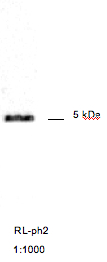Catalogue

Mouse anti M13 phage coat protein g8p
Catalog number: MUB0604P| Clone | RL-ph2 |
| Isotype | IgG2a |
| Product Type |
Monoclonal Antibody Primary Antibodies |
| Units | 0.1 mg |
| Host | Mouse |
| Species Reactivity |
M13 phage |
| Application |
Flow Cytometry Immuno-affinity-chromatography Immunocytochemistry Western Blotting |
Background
The display of repertoires of antibody fragments on the surface of filamentous phage offers a new way to produce immunoreagents with defined specificities. Phage derived antibody fragments offer a number of advantages over Mouse monoclonal antibodies, such as better clearance from the blood, the possibility to select from Human combinatorial libraries and the relative ease by which such fragments can be manipulated. The phage display technique thus facilitates the selection of antibody fragments of therapeutic value or research interest. Antibodies to M13 filamentous phage coat proteins are instrumental in the selection and detection of phages expressing specific antibody fragments or peptide sequences at their surface.
Source
RL-ph2 is a mouse monoclonal IgG2a, κ antibody derived by fusion of SP2/0-Ag14 mouse myeloma cells with spleen cells from a Balb/c mouse immunized with isolated M13 phage coat proteins.
Product
Each vial contains 100 ul 1 mg/ml purified monoclonal antibody in PBS containing 0.09% sodium azide.
Purification Method: ProtG affinity purification
Specificity
RL-ph2 reacts with the major M13 filamentous phage coat protein g8p with a molecular weight of 5 kDa.
Applications
RL-ph2 is particularly useful for immunoblotting of separated phage proteins, and is also suitable for detection of M13 phages in multistep immunoblotting procedures, immunocytochemistry, flow cytometry, affinity chromatography and ELISA. Optimal antibody dilution should be determined by titration; recommended range is 1:25 – 1:200 for flow cytometry, and 1:100 – 1:1000 for immunoblotting applications.
Storage
The antibody is shipped at ambient temperature and may be stored at +4°C. For prolonged storage prepare appropriate aliquots and store at or below -20°C. Prior to use, an aliquot is thawed slowly in the dark at ambient temperature, spun down again and used to prepare working dilutions by adding sterile phosphate buffered saline (PBS, pH 7.2). Repeated thawing and freezing should be avoided. Working dilutions should be stored at +4°C, not refrozen, and preferably used the same day. If a slight precipitation occurs upon storage, this should be removed by centrifugation. It will not affect the performance or the concentration of the product.
Shipping Conditions: Ship at ambient temperature.
Caution
This product is intended FOR RESEARCH USE ONLY, and FOR TESTS IN VITRO, not for use in diagnostic or therapeutic procedures involving humans or animals. It may contain hazardous ingredients. Please refer to the Safety Data Sheets (SDS) for additional information and proper handling procedures. Dispose product remainders according to local regulations.This datasheet is as accurate as reasonably achievable, but Nordic-MUbio accepts no liability for any inaccuracies or omissions in this information.
References
1. Meulemans, E. V., Nieland, L. J., Debie, W. H., Ramaekers, F. C., and van Eys, G. J. (1995). Phage displayed antibodies specific for a cytoskeletal antigen. Selection by competitive elution with a monoclonal antibody, Hum Antibodies Hybridomas 6, 113-8.
2. Meulemans, E. V., Slobbe, R., Wasterval, P., Ramaekers, F. C., and van Eys, G. J. (1994). Selection of phage-displayed antibodies specific for a cytoskeletal antigen by competitive elution with a monoclonal antibody, J Mol Biol 244, 353-60.
Safety Datasheet(s) for this product:
| NM_Sodium Azide |

Figure 1. Immunoblotting of RL-ph2 recognizing M13 phage coat protein g8p at a 1:1000 dilution.

